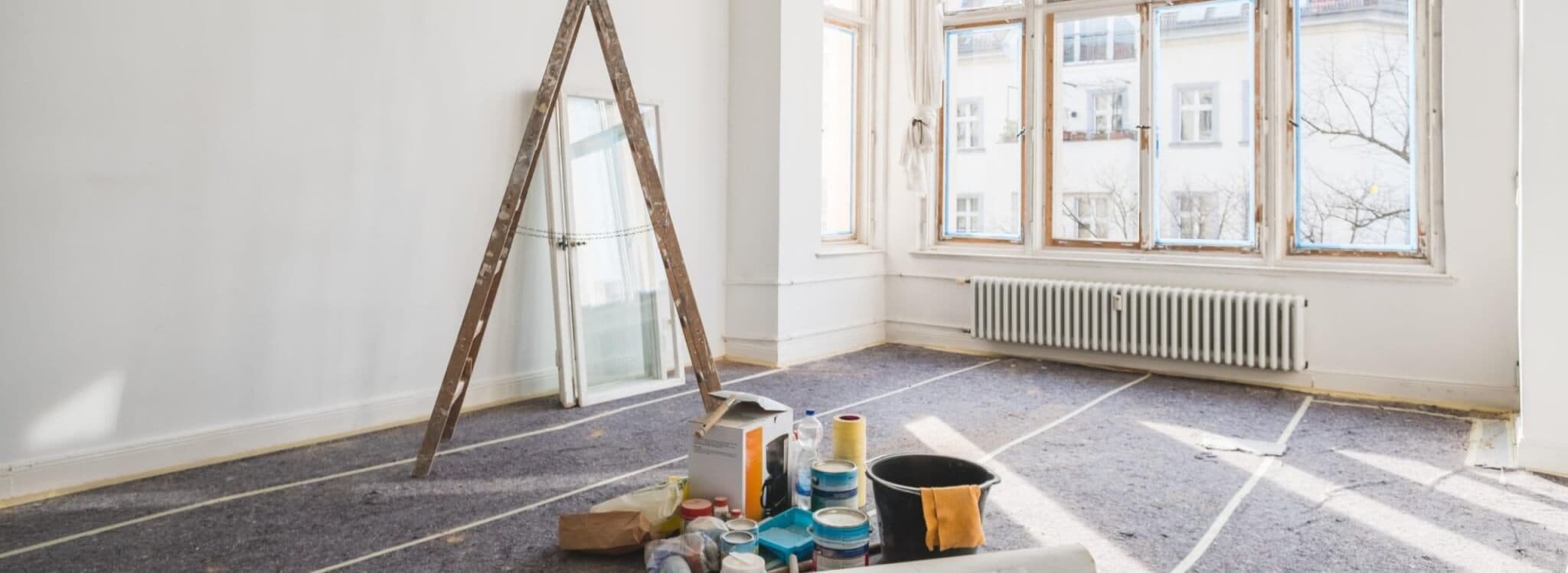Financing a Home Renovation: What Construction Loan Is Best?

Making home renovations has two obvious perks. First, you can make upgrades that fit your lifestyle and allow you to enjoy your home even more. Second, the upgrades you make now may help increase the value of your home, so that when it comes time to sell, you make a profit.
However, the way you fund your home renovation can have serious implications for your short- and long-term finances. For repairs that will cost more than you can afford to pay in a month, you may want to look at financing options beyond your credit card. That way, you can avoid paying the high interest rates that come with a credit card balance.
If you don’t have the savings stashed away to fund your renovations, you do have other options. You can build your cash flow for home renovations, use your home equity, or use a home renovation loan.
How Does a Construction Loan Work?
Construction loans — also known as home renovation loans or home remodel loans —are a common way to finance home improvement projects, as they often have lower interest rates than credit cards. With a home loan for construction, renovation costs are rolled into your mortgage, so you’re essentially making one payment each month that includes both the cost of your home and the repairs or upgrades you plan to make.
This can be beneficial if you’re purchasing a fixer-upper, but if you’re already in your home, the cons may outweigh the pros as your new mortgage payment may have a higher interest rate. And, while renovation loans may be more appealing for homeowners without home equity, homeowners with home equity have additional options for accessing funds.
There are three main types of renovation loans that allow homeowners to make updates now rather than waiting to have enough cash saved.
FHA 203(k) Loan
Insured by the Federal Housing Administration, the 203(k) loan comes in two forms: standard and limited.
The standard 203(k) loan covers major structural repairs and other renovations that cost at least $5,000. There is no cap on repair costs, however, you have to hire a U.S. Department of Housing and Urban Development (HUD) consultant to oversee renovations and projects. The HUD lists the projects covered by a standard loan.
The limited 203(k) loan is capped at $35,000 for renovations, not including structural repairs.
Pros to 203(k) loans:
- Can use a standard loan to tear down and rebuild on the foundation.
- Potentially easier to secure funding; since they’re insured by the government, lenders may have less strict credit qualification requirements.
- If your home isn’t inhabitable as you make renovations, you may be able to include up to six months of mortgage payments in your loan. You can continue to make monthly payments, but live elsewhere.
Cons to 203(k) loans:
- No do-it-yourself work with strict requirements on what renovations are covered.
- Must use an FHA-approved lender.
- Cannot use this loan with the intention of flipping the house or on homes that are under a year old.
- With the standard loan, funds that aren’t going to the seller (if buying the house) or to pay off an existing mortgage (if refinancing) are placed in an escrow account and released as rehabilitation is completed.
- Improvements must be completed 60 days from the loan’s closing date for limited loans and within six months of closing for standard loans. You will need a detailed estimate of the cost of work to be done and timeline from your contractor before your loan is approved.
HomeStyle Loan
Offered by Fannie Mae, HomeStyle loans are one of the more flexible renovation loans in that there are fewer restrictions on what you can use the funding for. Homeowners can get 75% of “the sum of the purchase price of the property, plus renovation costs,” or 75% of the “as completed appraised value of the property” — whichever is less.
That means if you’re refinancing your home, an appraiser will estimate the value of your home post-renovations. If they determine the value of your property with renovations completed will be $300,000, then the financing amount can’t exceed $225,000.
Pros to HomeStyle Loans:
- Can use funds for almost any renovation project, whether cosmetic or structural, including “luxury” updates like a swimming pool or landscaping.
- Can use the loan on an investment property.
- Can complete final work on a brand-new home, as long as the new home is 90% complete.
- Like a 203(k) loan, you may be able to include up to six months of mortgage payments in your loan if you need to live elsewhere while renovations are completed.
Cons to HomeStyle Loans:
- Like the 203(k) loan, your money sits in an escrow account and contractors get paid once they complete certain renovation tasks.
- Must use a certified contractor who needs to include a detailed cost estimate of the work you want done — potentially before the loan is approved.
CHOICERenovation Loan
Guaranteed by Freddie Mac, the amount of money you can receive for renovations using a CHOICERenovation loan is similar to the HomeStyle loan in that you can make renovations that cost up to 75% of the as-completed appraised value.
Pros to CHOICERenovation Loans:
- Can use the loan to repair your home if it’s been hit by a natural disaster or to fortify it against a future disaster.
- If buying a home and taking out a loan like Freddie Mac’s Home Possible loan, you may be able to make DIY renovations in exchange for sweat equity (but you’ll need to go through an appraisal before and after improvements).
Cons to CHOICERenovation Loans:
- All renovations must be completed within a year.
If none of the specialized loans above make sense for you due to use restrictions or approval criteria, yet another option for financing fixes is using a personal loan as a home improvement loan or home repair loan. They typically don’t require any collateral and provide funding quickly, but come with high interest rates and additional monthly payments, so it’s important to do your homework.
Read 5 home renovations to make before you sell >>
Other Home Improvement Financing Options
When you get a home renovation loan, you generally must use the funds toward making home improvements, often with strict requirements about what qualifies. The paperwork involved will be similar to when you first took out your mortgage.
That can slow down the process and, if your mortgage is locked in at a low interest rate or you only have a handful of years left to go on your mortgage, you may not want to mess with it (of course, if you can lower interest rates and/or the time left on your loan, you’ll want to do the math to decide if these options make the most sense).
Current homeowners should first look at how much equity they have built in their homes and the ways they can access that money. That way, you also won’t be saddled with closing costs and other fees associated with refinancing.
Compare your options: Get cash for your home equity
A home equity investment allows you to get a portion of the value of your home in cash now in exchange for a share of the future value of your home. Since it’s an investment, there are no monthly payments. You settle the investment within 10 years with the profits of a home sale, with savings, a refinance, or a loan.
Once you have the cash, you can make whatever home improvements you’d like, including improvements on an investment property, vacation home, or multiple properties.
Some home equity investments, like that offered by Hometap, also offer renovation adjustments. That means you can request an adjustment to the home value at time of settlement to account for any appreciation in the value of the property as a result of certain qualified renovations amounts costing $25,000 or more.
When you complete your renovation, you provide Hometap with the evidence of the renovation, including receipts and photographs of the renovation work. If approved, following an appraisal, the amount of a renovation adjustment will be the difference (as determined by an appraiser) between the appraised value of the property post-renovation and the hypothetical value of the property without renovations. Accepted renovation adjustments are not guaranteed.
Read Matt’s story about how he used an equity investment to build a rental property for additional income.
Pros to home equity investments:
- No time limitation on renovation projects; investment is settled within 10 years.
- Homeowners can fund DIY projects, outsource to professionals, and have no limitations on who to hire or types of projects.
- No monthly payments.
Cons to home equity investments:
- Investment is settled within 10 years, which means if the homeowner doesn’t plan to sell the home and use the proceeds to settle, they will use savings, refinance, or take out a loan.
- Must have a minimum of 25% equity in the home to qualify.
Which Renovation Loan Is Best?
The best way to finance a home renovation will depend on the renovation you want to make, your current financial situation and future financial goals, among other factors.
Look into all of your options and consider the renovations you want to make. Some renovations have a higher return on investment than others, so you’ll want to prioritize projects that you may need, but also the ones that will help increase the value of your home.
See how homeowners have used Hometap to fund renovations »
The more you know about your home equity, the better decisions you can make about what to do with it. Do you know how much equity you have in your home? The Home Equity Dashboard makes it easy to find out.
You should know
We do our best to make sure that the information in this post is as accurate as possible as of the date it is published, but things change quickly sometimes. Hometap does not endorse or monitor any linked websites. Individual situations differ, so consult your own finance, tax or legal professional to determine what makes sense for you.




